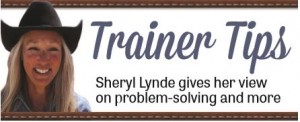 If you incorporate more pauses in your training regimen, your lessons will be more effective.
If you incorporate more pauses in your training regimen, your lessons will be more effective.
Also, be clear as to what you are trying to achieve. This may sound obvious, but more often than not I see an honest try made by the horse go unnoticed – and therefore unrewarded by the rider.
For instance, a common behavior riders agonize over is a disrespectful horse, either on the ground, in the saddle, or both. Behaviors range from biting and rearing to being run over while leading. Problems that you experience on the ground need to be fixed on the ground. Problems that you experience in the saddle need to be fixed in the saddle.
A horse that is pushy on the ground typically lacks a back-up. The longer the behavior has been allowed to persist, the more dangerous it can be. When working with a pushy or aggressive horse, make sure you have the skills to handle this behavior safely. If not, you need to hire a professional trainer to help correct the behavior. When a horse lacks respect of personal space, they are exerting their dominance. When you observe dominant behavior, it is initiated by forward movement. Disrespectful behaviors, such as but not limited to nudging and biting, are initiated by forward movement. The horse is trying to exert his authority over his handler by using his body to literally take the ground that you are standing on.
To thwart his forward movement which is at the core of his behavior, I would teach this horse to back up. The key is “energy”. If the horse’s forward movement toward you is at a Level 4 of energy exerted, I will ask them to back up with energy at a Level 5. For a horse, backing up is a submissive act. It is not usually executed by a horse who believes they are higher in the pecking order without a bit of defiance.
The proper equipment is imperative. I use a halter with a lead line that is a minimum of 10 feet in length. I’ll begin the lesson with my three rules in mind: (1) I cannot get hurt, (2) my horse cannot get hurt, and (3)he has to be calmer at the end of the lesson than when we began.
I will start in a large fenced area. The ample space will keep me safe, and in the event my horse pulls out of my hands, the fenced area will keep him contained. I stand in front of the haltered horse at a distance of at least eight feet with my shoulders squared to his. I’ll twirl the end of my lead rope in a circular motion toward his shoulder. The shoulder is targeted using the end of my lead rope, my eyes, and my body posture, in order to be clear as to what body part I want to move back.
I will continue increasing the energy with my lead rope and forward movement toward the horse’s shoulder until he takes a step back. Depending on the severity of the behavior, I can expect defiance. Defiance can be expressed any number of ways, from a charge toward me to a rear. Since dominance is initiated by a forward movement, the horse will be defending his position in the pecking order. By not allowing him to move forward, his alternative is to charge or rear. Backing is not an option to him at this point because it would mean submission. Being a herd animal, there is only one relationship between the human and the horse. Either the human is the leader, or the horse is the leader.
If he charges toward me, I have to be ready to take action as soon as he makes that first step. I target his shoulder and escalate the pressure with my lead rope at whatever level of energy is necessary for him take a step back. If he rears, I will wait until his front feet hit the ground, and then again continue my pressure until he makes an effort to back up. As soon as he takes a step back with the energy I am requesting, I release all pressure and allow him to stand for a minute so he is clear as to what I want.
After giving him time, I repeat my steps toward getting him to back up. I continue to repeat my steps until he backs at the onset of my request without the threat of a charge or rear. Then I will give him a break and let him soak. A release of pressure is given any time the horse makes an effort. A break in your lesson is given anytime the horse has made a change.
* Sheryl
Leave a Comment
All fields must be filled in to leave a message.